Times Have Changed
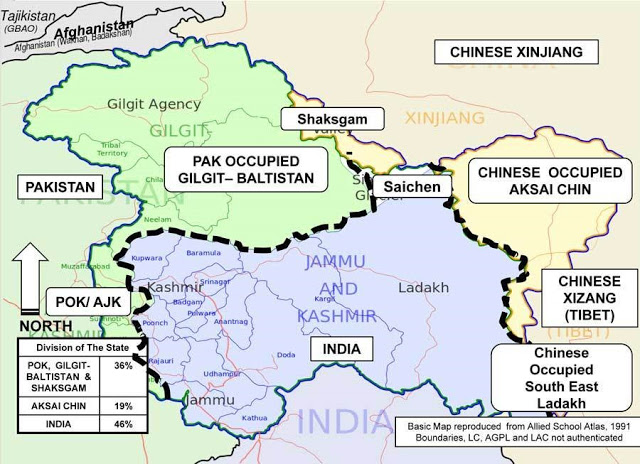
Abrogation of Article 370 has changed the Indo-Pak landscape in toto. It has irreversibly cemented J&K as an integral part of India like other states. It has brought into focus the future of illegally occupied POK and Gilgit-Baltistan. The statements of Shri Rajnath Singh that further dialogue with Pakistan will be on POK has deep ramifications.
Maharaja Hari Singh acceded the complete state of Kashmir including Gilgit, Baltistan, Kashmir, Jammu, Leh and Ladakh to India in 1948. These areas were never acceded to Pakistan. Were they? Hence all this is Indian Territory. On the other hand, Pakistan signed a standstill agreement with the ruler but broke it and invaded Kashmir[1]. Pakistan occupied POK by force. Gilgit and Baltistan were amalgamated into Pakistan through British perfidy. Pakistan has consistently denied treating these areas as its provinces[2]. These areas have been in illegal occupation by Pakistan for seven decades. However, times and conditions have changed. A revisit is warranted.
POK and Gilgit-Baltistan have been governed through extra judicial and legislative mechanisms outside the Constitution of Pakistan. People of POK and Gilgit-Baltistan have been consistently told that they are not an integral part of Pakistan. Article 257 of the 1973 Constitution of Pakistan states, “When the people of the State of Jammu and Kashmir decide to accede to Pakistan, the relationship between Pakistan and the State shall be determined in accordance with the wishes of the people of that State.” However, it does not specifically mention that the regions of the state that it presently occupies are part of its territory. [3] In September 1994, the Supreme Court held that since the Gilgit-Baltistan region was not part of Pakistan, the judicial matters pertaining to it were outside the purview of the Pakistani courts[4]. Ipso facto Gilgit-Baltistan is legally not part of Pakistan. POK and Gilgit- Baltistan whether they were a single territorial unit (earlier) or bifurcated (now), have been administered under special Councils headed by the Prime minister of Pakistan without representation in the Pakistan national assembly[5] or recourse to the supreme judicial processes of the land. Simply put, POK and Gilgit-Baltistan are not an integral part of Pakistan. They were acceded to India. Hence, these Indian Territories should be taken back. Time to start that process.
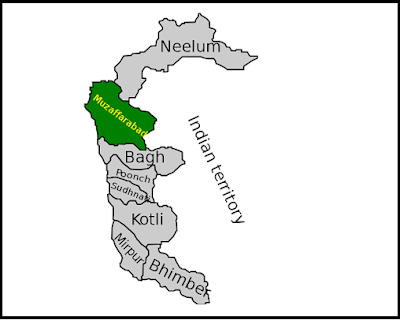 We could commence the process after Kashmir stabilizes so that we do not bite more than we can chew. However, the Kashmir problem is seven decades old and will take some time to stabilize. Retaking POK and Gilgit- Baltistan will also take time. They need not be serially linked but can be pursued in parallel. The momentum and initiative are with us. We should not soft pedal. Commencing the process will change the narrative. Controversial and illegal projects like CPEC and illegal cessation of the Shaksgam Valley by Pakistan to China will be revisited. A wedge should be driven between Pakistan and China to reduce their collusivity against India.
We could commence the process after Kashmir stabilizes so that we do not bite more than we can chew. However, the Kashmir problem is seven decades old and will take some time to stabilize. Retaking POK and Gilgit- Baltistan will also take time. They need not be serially linked but can be pursued in parallel. The momentum and initiative are with us. We should not soft pedal. Commencing the process will change the narrative. Controversial and illegal projects like CPEC and illegal cessation of the Shaksgam Valley by Pakistan to China will be revisited. A wedge should be driven between Pakistan and China to reduce their collusivity against India.
Pakistan Occupied Kashmir
POK covers an area of 13,297 square km with a total population of about 4.5 million. It has borders with Pakistan’s Punjab (South), Khyber Pakhtunkhwa (west), Gilgit and Baltistan(north) and Jammu and Kashmir (East). It is about 16 to 60 km in width and 400 km in length. It has high hills to the North petering down to plains of the South like on own side of LOC . The population is mostly Muslim. Majority population is Punjabi and not Kashmiri due to a planned demographic inversion. It also resulted in sectarian inversion with Shias rendered into a minority. There is very little cultural affinity to people in India anymore. Agriculture is the main occupation with very little industry. The literacy rates are better than rest of Pakistan. There is a sizable expat population which is settled abroad, largely in UK.
Though termed as ‘Azad’ Kashmir, there is hardly any ‘Azadi’ for even a bird to fly freely. Pakistani authorities allow very few freedoms. For three decades it has been a recruiting, training, logistical and launching base for state sponsored terror groups. It has a high density of Army deployment. Land ownership by retired military personnel is high. The 2005 earthquake resulted in a lot of Internally Displaced People(IDPs) who have been neglected [6]. Sub-surface simmers with unrest, disaffection and discontent [7]. Nationalist groups demand independence. Their leaders, driven out of the country, operate from abroad. There are regular anti-Pakistan protests on water and environmental issues.[8] There are protests on enforced disappearances like elsewhere in Pakistan[9]. Clashes with security forces take place[10]. However, people in this region might not display much affinity to India since they have been at the receiving end in three wars and in cross LOC duels. This was evident in the treatment of Wg Cdr Abhinandan when he bailed out in POK. One must be sensitive with the population to win them over. If the tabloid reports in Indian media are to be believed Imran Khan was confronted with slogans of ‘Niazi Go Home’ and ‘Kashmir Banega Hindustan[11]’. That is ominous and the ground might be shifting.
Gilgit- Baltistan (Balwaristan)
Gilgit-Baltistan shares borders with POK (South), Khyber Pakhtunkhwa (West), Wakhan Corridor (North), Xinjag (East and NE) and Leh (SE). It is also known as Balwaristan. It encompasses an area of approx. 73000 sq km with a population of about 2 million. Literacy rate is high. Its topography is like Leh. High wind-swept plains and snow-clad mountains. It is in the lap of the greatest mountain ranges of the world – Hindukush, Pamirs, Karakorams and Himalayas. Agriculture and Mountaineering Tourism dominate the
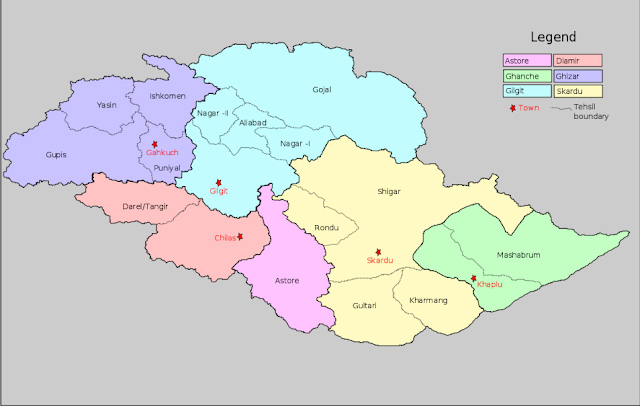
economy. Skardu is connected to the Leh region through the Indus and Shyok waterways. The Karakoram highway runs from Islamabad, Gilgit, Kunjerab Pass and Kashgar. This is the backbone of the CPEC also. The Indus collects most of its waters in Gilgit – Baltistan. In fact, water security of Pakistan hereafter will be at the expense of Gilgit and Baltistan. It is an area of significant strategic importance. It gives India a direct overland access to Afghanistan (Wakhan Corridor) and the Central Asian Republics.
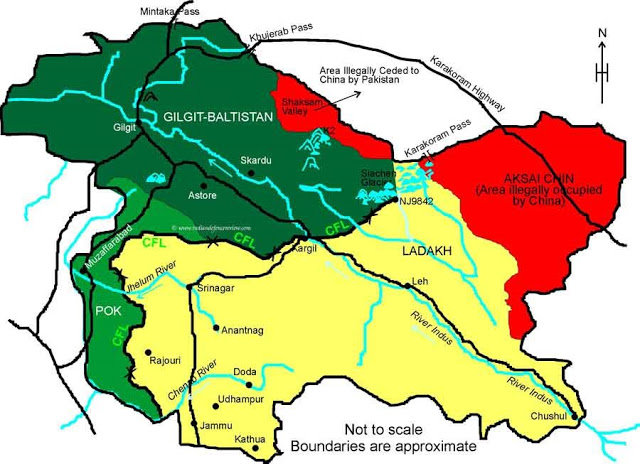
‘GILGIT-BALTISTAN is a simmering cauldron of discontent. The continued deprivation of political, economic and human rights is driving the people of this strategic northern end of Pakistan to desperation’. [12] Initially people of this area wanted to be part of Pakistan as its province. This was denied to them. In 2009, the Gilgit-Baltistan Empowerment and Self-Governance Order gave them some rights, but were rolled back by the new Gilgit-Baltistan Order in 2018. Deprived of constitutional rights, they are now aggrieved. It is a tribal area. The population was predominantly Shia. Though it is still a Shia majority region, a huge Sunni Influx has been encouraged; which upset the ethnic balance and gave rise to sectarian strife[13] [14]. Gilgiti and Balti soldiers have sacrificed their lives for Pakistan without recognition. Poor treatment of N Li soldiers in the aftermath of the Kargil War is not forgotten. The Karakoram Highway pollutes the environment. It has also brought in drugs and guns. Land acquisition for CPEC is without due compensation for the community, since it is customarily “common land”. CPEC is also depriving them of livelihood due to influx of Chinese labor. People are anti-CPEC and anti-Chinese. The area has been kept underdeveloped deliberately and in abject poverty. it is said that “Local wisdom dictates that when it suits Pakistan, GB is a formal part of the country; and when it suits Pakistan to show GB as a disputed territory, it is shown as that.”[15] The disaffection rate is high. Large scale disturbances and agitations are envisaged[16]. Overall in this backdrop of sentimental, ethnic, legal, economic, political strife and uncertainty, scrapping Article 370 has spurred people to look beyond Pakistan. Very clearly there are indications that activists are knocking at various doors to get rid of the Pakistani yoke. The Balwaristan National front seeks Independence from Pakistan. There is even a nascent sentiment to join India[17].
Strategic Approaches
Political Decision. The first national political decision should be restitution of the ground positions in POK and Gilgit-Baltistan to the cartographic borders as depicted in various maps of India. The political decision to retake the area must be firm, clear and unambiguous. It should not just be post 370 rhetoric. It is a commitment in which India should be prepared to invest for the long haul with consistency and sincerity.
Unified Policy. Irrespective of the Government or party in power, we should stay the course without policy flip flops. Hence we need inner political consensus at a national level rising above narrow political ideologies. Our motor mouth politicians should not upset the apple-cart with loose statements.
Internal Understanding. The center of gravity in retaking POK and Gilgit-Baltistan is winning over the people. That means an understanding that India will be taking on board 5 million Muslims more. All religious, ethnic and ideological hardliners need to be tempered. We cannot spook the scared kitten.
De-hyphenation. POK and Gilgit-Baltistan are distinct and different. The people of Gilgit-Baltistan do not want to get clubbed with POK. Each area leads to a different strategic objective. POK puts you on the doorstep of Islamabad. Gilgit-Baltistan gives you access to Afghanistan and destroys Pakistani status of a ‘frontline’ state. POK and Gilgit-Baltistan should be de hyphenated and pursued as different objectives. It will force Pakistan to look in multiple directions. Wherever Pakistan yields will be our gain.
Strategic Communication. Strategic communication will play a huge part. A perception is already forming that India is changing the game. The message to China and Pakistan to stop CPEC projects in POK and Gilgit-Baltistan is the opening gambit[18]. The follow up will include communicating and opening a direct channel to the people of POK and Gilgit-Baltistan. It could be like the Republic Day address of PM in 2015 when a mention of Baluchistan was made. Strategic communication must be thought through and executed as per a plan.
Timing. ‘Now’ is the best time to start the process. Pakistan is down on many counts. Pakistan is responding to India’s political gambit with military hype through a drummer boy PM to provoke war. It is totally off beat. China is caught in an economic slowdown, trade war and its own homeland problems amidst a global recession. The international community is also a bit fed up of Pakistani antics and will give tacit support to India if not for anything else. The USA might see it as a great opening. That is if we play our cards right.
Diplomatic Outreach. Restoring POK and Gilgit-Baltistan to India is only a correction of an historical anomaly. Diplomatic outreach to the international community should project India’s principled stand. USA should be taken on board. USA has relied on its double dealing ‘front-line’ partner to thwart Homeland Security threats emanating from Af-Pak area. If POK and Gilgit-Baltistan are re-amalgamated into India, stabilization of Afghanistan will be facilitated by a reliable strategic partner. US think tanks can start considering this perspective instead of creating 2-3 unstable countries as envisaged by Selig Harrison in Carnegie Endowment. What of China? China did not show any morality in claiming the nine-dash line, forcibly occupying Spratly Islands or in rejection of ICJ ruling. It should be told off accordingly.
Hard vs Soft Power. Soft power must take lead. Media, Bollywood, understanding tribal culture, democracy, aspirations, shared socio-economic values, history, religion et al should be employed to win the people over and start a people’s movement. Hard power can follow once the ground is made. It is economic and political part of hard power which needs to roll out. The omnipotent military part should be the last resort and the least component. However, at some stage we might have to resort to hard power and at that time we should not hesitate.
Non-military Non-nuclear. There is lot of talk and hype about retaking POK and Gilgit Baltistan militarily. Any military option will raise the nuclear stakes to an unacceptable level. That is precisely what Pakistan wants! Pakistan Army is professional and will be more than a match along the LOC if we are bull headed. Our approach must be non-military non-nuclear and indirect. Planners should read Liddel Hart’s classic – ‘The Strategy of Indirect Approach’ before embarking on this venture. Most importantly we must learn from abrogation of Article 370. The political rapier cuts better than military hammers. Reinforce success please.
Avoidance. ‘Pakistan has given India repeatedly the opportunity to present the unrest in Kashmir to the world as nothing more than a Pakistan-backed insurgency. This has effectively undermined the struggle of the local population of Indian-administered Kashmir’[19]. This approach that must be totally avoided.
Operational Lines of Action
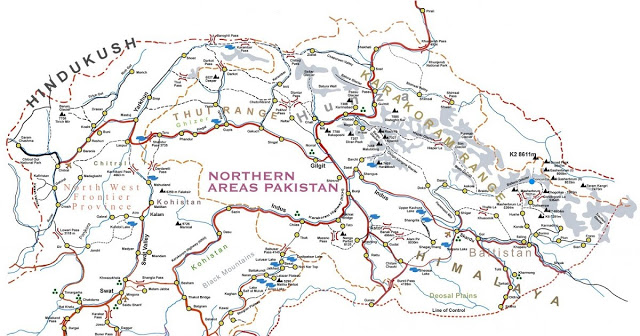 General. Once the strategic issues are in place and policy decisions taken, there are plenty of lines of action. these should be dynamic and responsive to situational demands. These these lines of action should exploit Pakistan’s fault lines. Some would be specific to POK and some to Gilgit-Baltistan. A one size fits all approach should be avoided. Flexibility should be built in. Some lines of action are outlined in succeeding paragraphs. More can be added by think tanks and planners.
General. Once the strategic issues are in place and policy decisions taken, there are plenty of lines of action. these should be dynamic and responsive to situational demands. These these lines of action should exploit Pakistan’s fault lines. Some would be specific to POK and some to Gilgit-Baltistan. A one size fits all approach should be avoided. Flexibility should be built in. Some lines of action are outlined in succeeding paragraphs. More can be added by think tanks and planners.
Political Lines. Politically communication to people in POK and Gilgit-Baltistan should highlight fruits of democracy and progress in India. Seats in J&K parliament kept historically vacant for these areas can be filled on nomination basis from displaced persons. They would then get representation in our democracy to air their grievances. Human rights record of Pakistan is a major fault-line to be exploited. Enforced disappearances in all parts of Pakistan is a major issue. Minority communities are being systematically targeted including Shias, Ahmadiyya’s, Hindus and Christians. Even Barelvi Sunnis are at the receiving end of this onslaught. Pakistan is an epicenter in a war of ideas that is taking place within the larger Muslim world.[20] Continuance in Pakistan confers them second-rate status. People who want to cross over can even be granted asylum.
Economic Lines. Pakistan is a failed state whose collapse is imminent. Pakistan has heaped only economic misery which can be exploited. Loss to the people for continuing in Pakistan needs highlighting. They contribute to the water security of Pakistan and get no compensation. CPEC is causing tremendous loss to them for other provinces to prosper. Allocation of CPEC resources is disproportionate in this area. Even availability of food and basic issues like roti’s are getting out of reach of the common man due to runaway inflation.
Diplomatic Action. A concerted diplomatic effort must be launched. There should be an outreach to all activists in/out of Pakistan to give them moral support. We should be able to give all organizations who seek independence from Pakistan a platform from which they can articulate their aspirations democratically. Diplomatic dialogue should begin with Pakistan for return of these areas to India. Any nations mediation offer for return of these areas can even be considered.
Social and Cultural Issues. Environmental degradation and its adverse effect on their lives needs highlighting. Education, jobs, development and social opportunities can be outlined. The demographic inversion of this region needs exposure. Chinese influx into the area is a live and current issue. The status and neglect of IDPs needs social focus. Neglect of people who have sacrificed their lives for Pakistan, especially from Northern areas must be highlighted. The tremendous soft power of our media can bring home these burning social issues to people.
Military Action. Military lines of action should be low key and well below the threshold of Pakistan’s redlines. All-out war scenarios are totally avoidable. Initially we should maintain a low-key military profile with a hybrid approach for which there is much scope. If the need arises, everyone concerned can be communicated that India will hold its ground with all resources at its disposal. Ultimately it will be the strength of the Armed Forces which will be the sheet anchor on which this entire campaign will be mounted.
Conclusion
It will be argued that it is not correct / imprudent for India to act in a manner which is being suggested. Well we are in a world of realpolitik and we should have the guts and gumption to retake what is ours. No one is going to hand it over a platter to us. Otherwise let us stop showing this area as ours on maps. Time for India to shed its softness. Having said this, we should set our own house in order. That implies within Kashmir and out of it. All this is possible by democratic consensus and cooperation and not by majoritarian attitudes or rhetoric. If we are not strong and united internally, we will not be able to with stand and overcome the combined onslaught of China and Pakistan. A strong blowback is only to be expected.
[2] https://www.dawn.com/news/1504360/revisiting-our-gilgit-baltistan-policy
[4] https://www.justice.gov/sites/default/files/eoir/legacy/2013/06/12/kashmir.pdf
[5] https://www.justice.gov/sites/default/files/eoir/legacy/2013/06/12/kashmir.pdf
[7] https://idsa.in/askanexpert/PakistandoesnotfacethesamesituationinthePOKasIndiadoesinJK
[12] https://www.dawn.com/news/881186
[13] http://www.newsweekpakistan.com/sectarian-strife-in-gilgit-baltistan/
[14] https://www.thenational.ae/sectarian-strife-in-pakistan-hurts-its-ties-with-china-1.379331
and https://www.dawn.com/news/1189255/challenges-for-gb-government All these articles and more are authored by Afzal Ali Shigri, a Balti who has been an IGP of Sindh. His articles in Dawn give you a true insight of the situation in Gilgit Baltistan.
[20] https://ctc.usma.edu/app/uploads/2011/05/CTC-OP-Abbas-21-September.pdf









